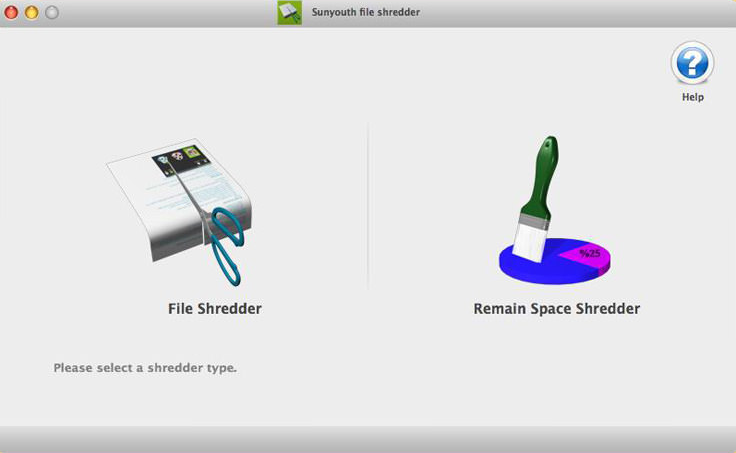

- BEST FILE SHREDDER FOR MAC HOW TO
- BEST FILE SHREDDER FOR MAC SOFTWARE
- BEST FILE SHREDDER FOR MAC WINDOWS

Large files, system cache, hidden and obsolete files, system logs, and widgets are a few prominent items that you should look for while performing a system clean up.
BEST FILE SHREDDER FOR MAC SOFTWARE
You can choose to do it manually but experts recommend the use of the best mac cleaner software for accurate and efficient results. If you are struggling with the slow performance of your Mac machine, then probably it’s time to perform a system cleanup to make your mac run faster.

Read More: Best File Shredder Software For Macĥ. Apart from this you can also consider deleting unwanted and useless files to enhance the overall speed and efficiency of your device. Use appropriate folders to sort and place various documents, photos, and files in an organized way. Experts recommend that if you want to speed up and make your mac run faster it is essential that you declutter and properly organize your desktop. Storing a huge number of items on your desktop space puts unwanted pressure on your RAM and storage space.
BEST FILE SHREDDER FOR MAC HOW TO
Read More: How To Clear Cache in Chrome, Firefox, Safari & IE Browsersĭesktop clutter can be another reason for your slow running mac. Thus cleaning system Cache is an essential activity if you want to enjoy uninterrupted working and speed up Mac OS.
BEST FILE SHREDDER FOR MAC WINDOWS
Next click on the “Minimize windows using” and turn off the Genie Effect and set the Scale Effect.Ĭache files are used to speed up certain processes of your device but with time they fill your storage space and instead of enhancing the speed it makes your device slow and sluggish. From the list of displayed items, untick Magnification, Automatically hide and show dock and Animate opening applications options. To start with Click on the System Preference Tab. If you are wondering how to speed up your mac device, try cutting down the visual effects to prevent slowdown. Too many visual effects add on to the overall appearance and makes it look pretty but also puts unnecessary stress on your system resources. Getting rid of unwanted extensions is always a good idea to make your mac run faster. More than adding on to system efficiency it makes it over-crowded and degrades the browsing speed. In an effort to simplify our task we often load our web browsers with several extensions and add-ons. So, now that you’re aware of some of the problematic areas, let’s discuss them in brief one by one. Uninstall unwanted and obsolete applications. Look out for resource hungry applications. Important Tips and Methods to Speed Up Mac:Īre you annoyed with the slow running speed of your mac? Do you want to make it run like a new machine? The simple tips discussed here will help you regain its lost speed and boost its execution speed and efficiency in no time. Fancy visuals that only aim at visual appearance. Low hard-disk space can be one of the integral factors for low speed and degraded system performance. Once the progress bar disappears, all files and folders that were in the Trash have been securely erased and are completely irrecoverable.Few Additional Tips Why is Your Mac Running Slow | Few Important Reasons. NOTE: The Secure Empty Trash process takes slightly longer than a normal emptying of the Trash because the files and folders are overwritten several times to make them unrecoverable. Click OK to start the secure deletion process. You will see a warning message alerting you that the files will be deleted. From the menubar, choose Finder > Secure Empty Trash. Click once on the Trash icon to open the Trash folder and make sure you are ok with permanently deleting all files and folders in the Trash. Drag the files or folders you wish to securely delete to the Trash, located at the far right end of the Dock. To Secure Empty Trash on a spinning hard drive: If it is SSD, you can only secure your files via File Vault. If it is Rotational, you can use the Secure Empty Trash below, or encrypt via File Vault. It will either say Rotational (spinning hard drive), or SSD. In the bottom right pane, look for the Physical Volume section. If there are two panes on the right, in the top right pane, click on the drive that is your main hard drive (typically Macintosh HD). In the System Information report, go to Hardware > Storage. Click either System Report or System Info. Click on the Apple logo in the menubar and select About this Mac. To check if your computer has a SSD or spinning hard drive (MacOS 10.11 or earlier): If you are using a Mac that is running macOS version 10.10 or earlier, and it has a spinning hard drive (typically all desktop Macs and most laptops that have a CD/DVD drive), you can either also use File Vault, or continue to follow the directions below to use Secure Delete when emptying the trash.







 0 kommentar(er)
0 kommentar(er)
